
Common Diseases of Hong Kong Crops
Powdery Mildew
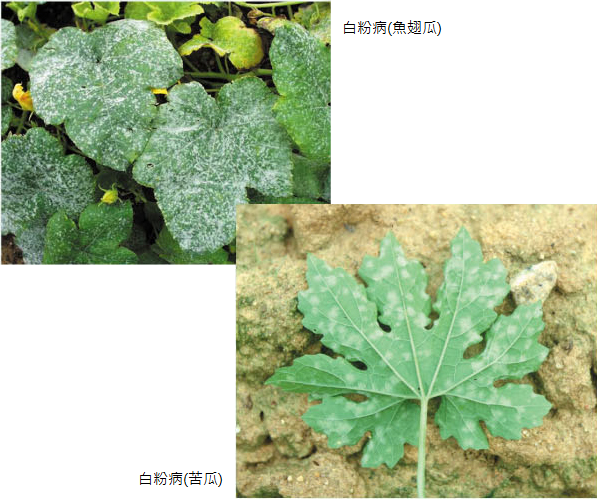
Damage to crop: Powdery mildew can be easily identified and appears as light grey or white powdery spots usually found on the infected region. The whitened part thickens gradually upon infection with color darkened. It could infect leaves, stems, petioles, and fruits. In the severe cases of infection, the whole infected leave will be covered with white powder, leading to the yellowing and wilt of leaves. The disease is spread by airborne conidia, which tends to develop and spread in spring and autumn (between April to September), particularly dim environments with variable humidity. Moreover, under wet and muggy weather, or in the presence of inappropriate amount of nitrogen-based fertilizer, powdery mildew thrives too.
Hosts: Common hosts of the powdery mildew include melons such as cucumbers, loofah, hairy gourd, bitter gourd, and wax gourd; solanaceous fruits such as tomatoes, eggplants, and peppers; legumes such as common beans and peas; and other crops such as lettuce, and cabbage, etc.
Prevention and treatment:
- Cultivate the disease-resistant germplasm.
- Keep good ventilation and avoid overcrowded planting.
- Use phosphorus and potassium fertilizers appropriately, avoid using excessive nitrogen-based fertilizers.
- Avoid irrigating on cloudy days. Keep the relative humidity low with moderate temperature when planting in the shed.
- Apply fungicide including palmityl alcohol, Triadimefon (XiuFengNing), diniconazole, Bordo Mix (Kasumin and Bordeaux mix), Chlorothalonil (2P47), Mancozeb (2P127) and Zineb (2P209).
- Fumigate with sulfur powder.
Downy Mildew
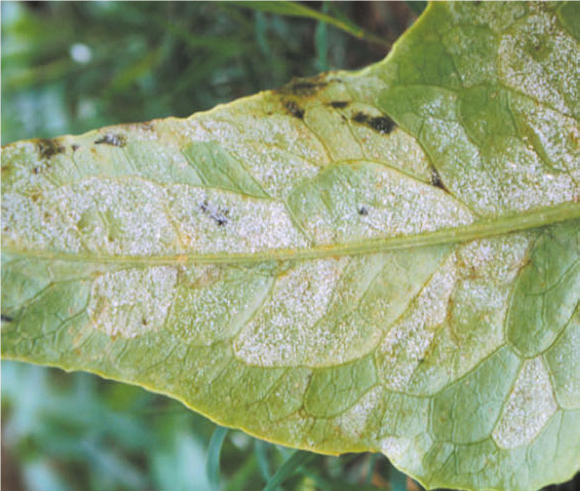
Damage to crop: Downy mildew is a disease caused by fungal infection, which mainly occurs in the foliage. Infected parts usually start with the appearance of pale green water-soaked patches. The infected part will later develop into gray, yellow, or greenish-yellow irregular patches on the upper surfaces of leaves. The undersides of the patches are covered with grey cotton-like fungi. The expansion of the infected area will gradually dry up the host. The downy mildew causing conidia can spread along air currents, water, or contact by insects. Downy mildew usually blooms under warm temperature and high humidity. Thrives of downy mildew are often associated with dense planting fields, high humidity, or the aging of hosts.
Hosts: Common hosts of the downy mildew include cruciferous vegetable such as Chinese white cabbage (Bok choy), flowering Chinese cabbage (Choy sum), Chinese kale, cauliflower, and carrot, lettuce, onion, spinach, and melons, etc.
Prevention and treatment:
- Cultivate disease-resistant varieties.
- Practice plant rotation.
- Remove stubbles and infected plants.
- Cover the field with organic matter or plastic film to prevent raindrops from splashing.
- Avoid overcrowded planting and keep good ventilation, build higher borders to facilitate the removal of excess water and keep the field humidity low.
- Apply fungicides such as Chlorothalonil (2P47), Mancozeb (2P127) and Zineb (2P209).
Rust
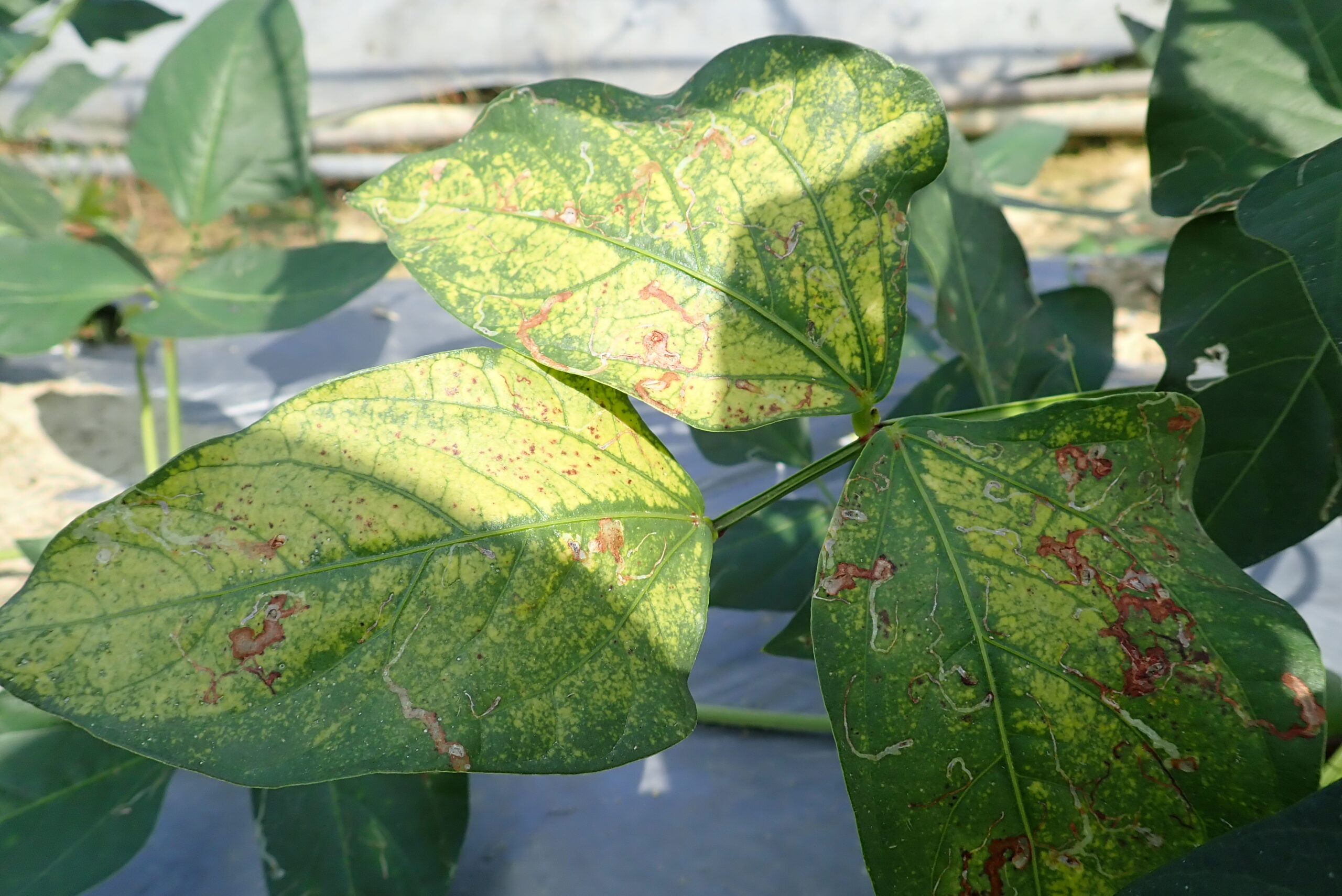
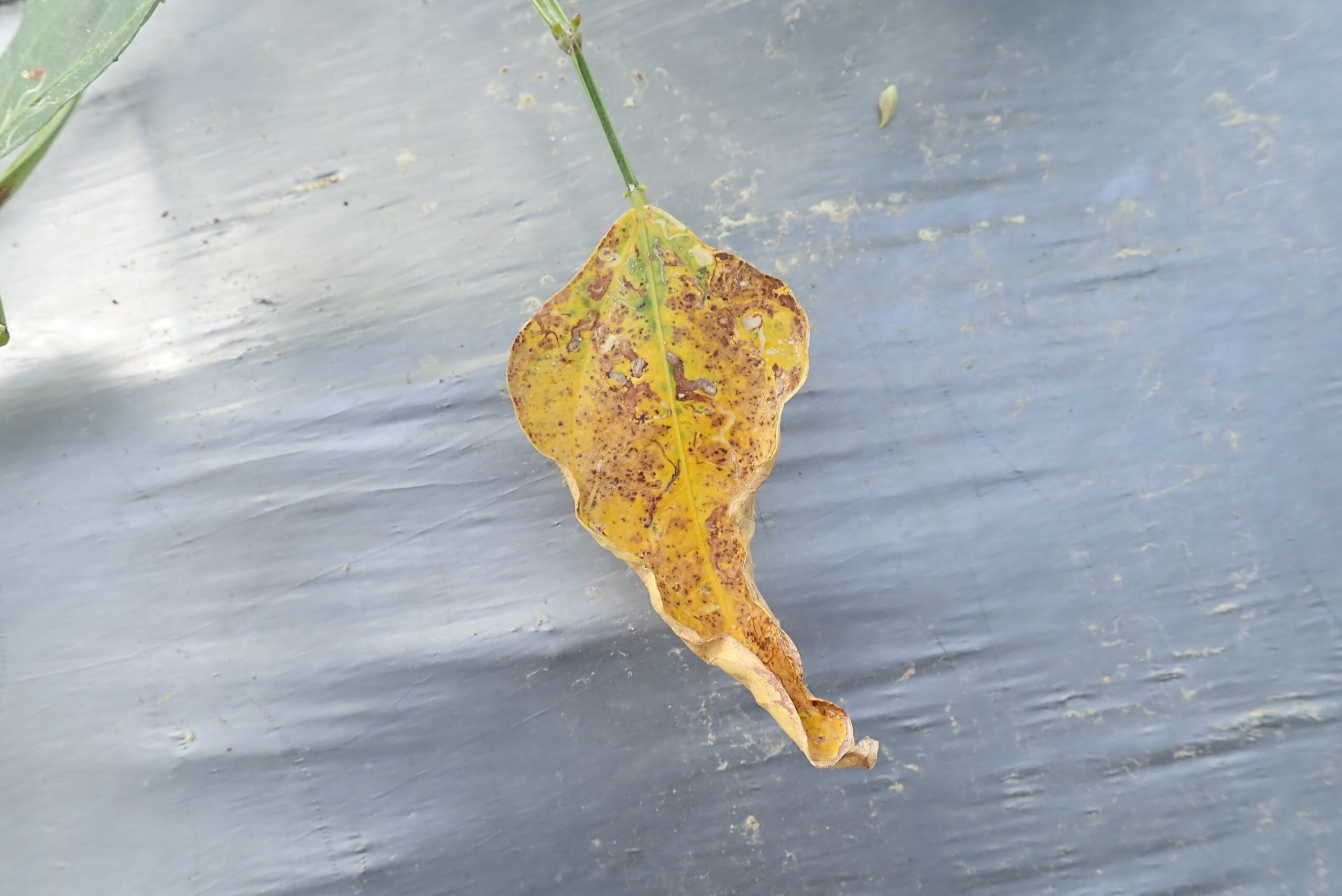
Damage to crop: The spores of rust fungi can be spread by wind, water droplets, or insects. Spore can germinate and infect the leaves, petioles, stems, and pods of host. During the early disease progression, yellowish-orange protruding spots are formed on both sides of leaves. The fungi penetrates the host and forms reddish-orange spores that gradually bursts to release spore for the next round of infection. In the severe infestation, the rust powder can cover the whole infected region, leading to the deformation and wilting of leaf, and affecting plant growth. Rust usually prevails during March to August and is spread especially during the flowering and pod setting stage with the warm temperature and high humidity, presence of excessive nitrogen-based fertilizer, and insufficient potassium fertilizer.
Hosts: Common hosts of the rust include leguminous crops such as pea and kudzu, garlic, garlic chives, etc.
Prevention and treatment:
- Cultivate disease-resistant varieties.
- Remove the infected plants, avoid overcrowded planting, keep good ventilation.
- Improve water supply system in the field, avoid excessive water.
4. Apply phosphorus-potassium based fertilizers and organic fertilizers and avoid applying excessive nitrogen-based fertilizer. - Spray fungicide as preventive measurement of rust, such as Chlorothalonil (2P47), Mancozeb (2P127), Copper II Hydroxide 77% WP (2P53), Zineb (2P194).
Soft Rot
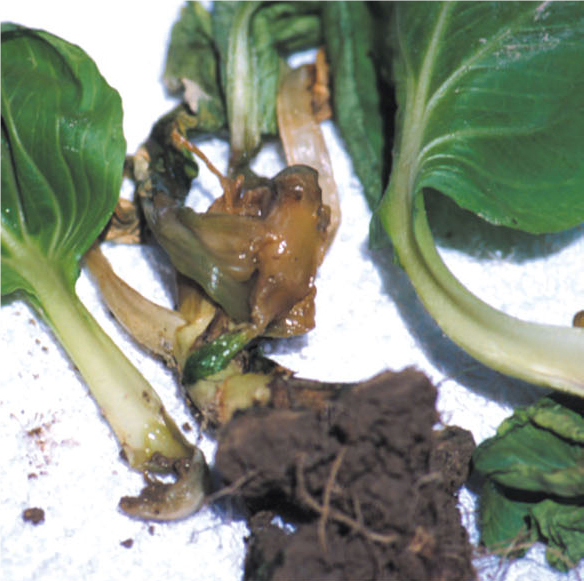
Damage to crop: Soft rot is spread by water and insects as bacteria vector. Water-like stains appear at the wounds of the leaves, stems or petioles of the host at the beginning of the infection. The stain will become liquidly mush with yellow-white snot-like mucus at the later stage. In some severe cases of infection, the whole infected area will decay to slimy mush with a foul odor.
Host: Common hosts of the soft rot includes solanaceous crops such as tomatoes, peppers, and potatoes, cruciferous crops such as Chinese white cabbage (Bok choy), flowering Chinese cabbage (Choy sum), radish, kale, broccoli, and cabbage, cucumbers, celery and onions and other vegetables.
Prevention and treatment:
- Practice crop rotation.
- Cultivate disease-resistant varieties.
- Turn the soil and dry the field with sunlight more often, ensure all the infected plant remains have been decomposed.
- Avoid making wounds on the plants, as pathogens are invaded through wounds.
- Apply the bactericide such as oligosaccharins, Kasugamycin, streptomycin, zhongshengmycin, copper hydroxide suspension or oxolinic acid etc.
White Mold (Sclerotinia Rot)
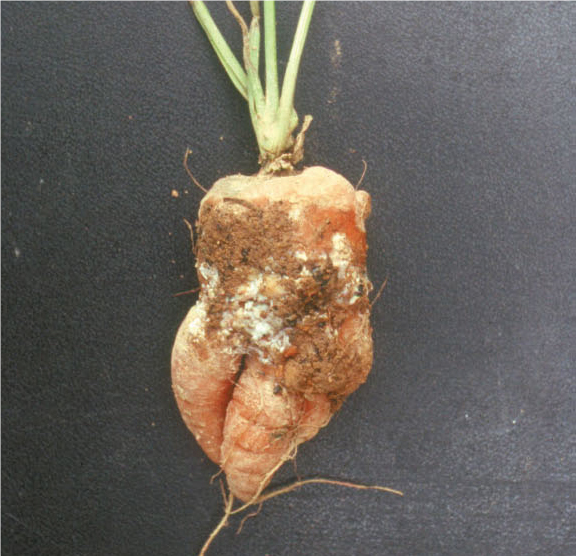
Damage to crop: The disease is spread by spores released by the Sclerotinia sclerotium and spread by air. The spores fall on the plant, and germinate under suitable conditions. Hyphae grow and invade the weakened plant parts, and eventually infect the plant host. It can infect leaves, stems, and fruits. White cottony hyphae grow on the infected area, and produce black resting structures known as sclerotia. Serve infection can lead to the death of the plant. Unlike bacteria-caused spoilage, the spoiled part is relatively dry and does not have a foul smell.
Hosts: Common hosts of the white mold include solanaceous crops such as tomatoes, eggplants, and peppers; melons such as cucumber and bottle gourd; lettuce, Chinese white cabbage (Bok choy), broccoli, and carrots, etc.
Prevention and treatment:
- Choose spore-free seeds. Or wash the seeds with 10% to 15% saline, select the sunk seeds and wash them with clean water. Dry them before sow.
- Practice crop rotation.
- Till the soil thoughtfully after harvest, bury the sclerotia in the ground. Cover the field with plastic, heating up the soil by sunlight to eliminate the sclerotia underground.
- Maintain good ventilation.
- Remove weeds, stubbles, and infected plants frequently.
- Apply phosphorus-potassium based fertilizer and avoid excessive use of nitrogen-based fertilizer.
- Spray fungicides such as prochloraz, carbendazim, and dimethachlon.
Anthracnose
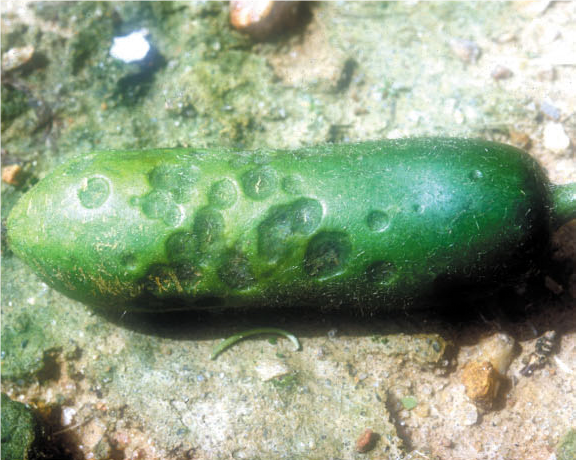
Damage to crop: The disease is spread by fungal spores released to air or water. It mainly affects fruits but also other plant tissues such as petioles, stems, and pods. At the early stage of infection, infected fruit develops yellowish-brown water-soaked lesions on the surface. The lesions would turn to darker brown in the late infection stage, and the fruit would rotten and become mushy soft inside. Under high humidity, the lesions would cover with red, gelatinous masses of spores. The infected leaf appears as water-soaked greenish round lesions. The disease spreads and flourishes with higher temperature and humidity. In addition, the environment with overcrowded planting, excessive nitrogen-based fertilizer, continuous cropping can lead to the thriving of anthracnose.
Hosts: Common hosts of anthracnose include melons such as cucumbers, loofah, hairy gourd and wax gourd. Solanaceous crops such as tomatoes, peppers, and eggplants; legumes such as common beans and peas; cruciferous crops such as cabbage, and radishes; and other asparagus, spinach, and lettuce, etc.
Prevention and treatment:
- Use non-infected seeds or sterilized seeds.
- Practice crop rotation.
- Apply an increased portion of phosphorus-potassium fertilizer with controlled watering.
- Avoid excessive water remaining in the field.
- Spray fungicide such as carbendazim, anthrax thiram wettable powder, thiram, sporgon, Dieldrin, chlorothalonil, and captan.
White Blister
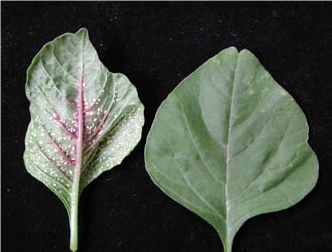
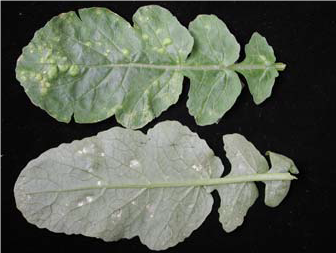
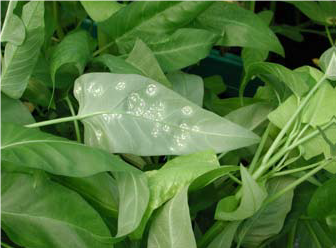
Damage to crop: White blister mainly occurs on the leaves. The infected region usually appears pale yellowish-green spots on the upper leaf surfaces, while there were powdery white blisters developing on the undersides of the infected parts. It may be mistakenly recognized as being caused by Coccoidea members or whiteflies. The oomycete will gradually spread to the newly formed seed pods, forming spore piles. And the infected flower organs are malformed and enlarged. White blister will lead to the death of the whole plant. A mild early infection can be controlled by spraying effective fungicide, but the seeds quality and quantity will be affected.
Hosts: Common hosts of the white blister include cruciferous crops such as Chinese white cabbage (Bok choy), mustard greens, and cabbage; convolvulaceous crops such as water spinach (Tung Choi) and sweet potatoes; amaranthaceous crops such as green amaranth, pointed-leaf green amaranth, and red amaranth etc.
Prevention and treatment:
- Cultivate disease-resistant varieties.
- Practice crop rotation.
- 3. Avoid planting cruciferous vegetable crops continuously. Overwintering oospore in the soil might cause the spread of white blisters in spring. Therefore, plant non-host crops such as onion and garlic between cruciferous vegetable cropping.
- Remove and bury the wilted plant.
- Spray fungicide specialized for white blister. Apply phosphorous acid-containing agents as preventive measurement.
Corynespora Blight (Target Leaf Spot)
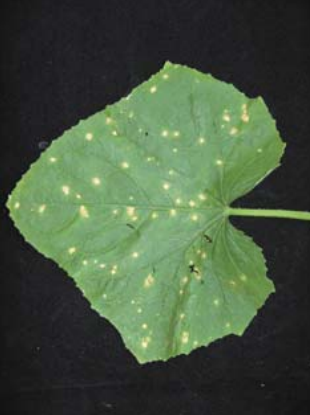
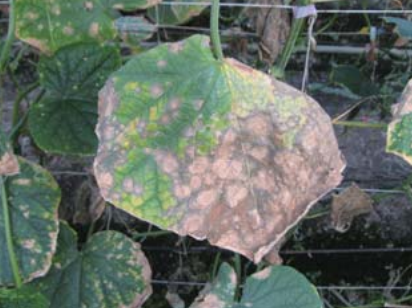
Damage to crop: Corynespora blight is a fungal disease that affects cucumbers and other crops. The infection appears as a grey leaf patch found on the lower portion of the cucumber plant. The lesions later develop into irregular light brown spots, the merging of lesions may lead to the wilting and death of infected leaves. Oval gray-brown spots may also appear on the stems and petioles during severe corynespora infection, which may lead to the death of the whole plant.
Hosts: Common hosts of corynespora blight include convolvulaceous crops such as water spinach and sweet potato; asteraceous crops such as lettuce and crown daisy; lamiaceous crops such as mint, basil, perilla (Zisu), rosemary, and motherwort; and other members of cucurbitaceous, solanaceous, cruciferous, and leguminous crops, etc.
Prevention and treatment:
- Sterilize the seed surface with warm water. Soak the seeds in 75℃ water for about 90 seconds, add water and stir until the mixture drops to about 30℃. Further soak and stirthe seeds for 4-6 hours, germinate the soaked seeds in the 25 to 28℃ incubator.
- Remove the infected plants’ stubbles in the field by tilling deeply after crop harvest. Tilling during the winter can help eliminate the pathogen of Corynespora and loosen the soil.
- Maintain good ventilation and keep moderate humidity in the field.
- Apply organic or natural fertilizer, such as manure, two-plus-one organic fertilizer, high-phosphorus-potassium compound fertilizer, and Palygouskite-based fertilizer etc.
- Remove the infected leaves at the early stage of the disease. Spray fungicide such as chlorothalonil (2P47), Azoxystrobin, Boscalid and Hexaconazole for effective prevention of corynespora blight.
Septoria Leaf Spot (Septoria Blight)
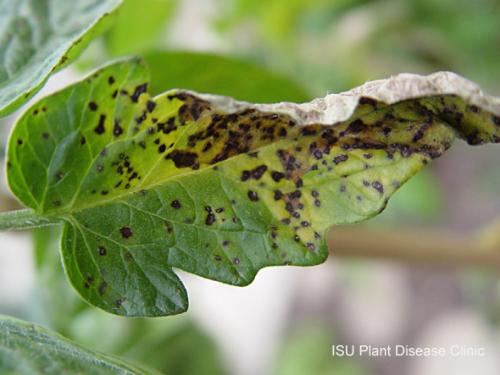
Damage to crop: Septoria blight is a fungal disease that can spread along air currents, water, or contact by insects. Oil-like stains will appear at the leaves, stems or petioles of the host at the beginning of the infection. The infection appears as oil-like stain (with diameter smaller than 5mm) found on the lower portion of the infected plant. The lesions later develop into irregular light brown spots lined with yellowish patches. Lesions stems or petioles are usually in oval shape. As the disease progresses, spore patches in black will evolve on the lesion for the spread of Septoria blight. The merging of lesions may lead to the wilting and death of infected leaves at the late stage of infection.
Hosts: Common hosts of Septoria blight include members of Apiaceae crops such as fennel, celery, coriander, and carrots, etc.
Prevention and treatment:
- Remove stubbles and infected parts. Burn or bury them deeply to avoid contamination.
- Use uninfected seeds or sterilize the seed surface with warm water. Soak the seeds in around 50℃ water for about 30 minutes and stir.
- Practice crop rotation.
- Sow the seeds earlier or late to avoid the peak season of disease.
- Keep the relative humidity low with moderate temperature when planting in the shed.
- Spray effective fungicide such as Chlorothalonil (2P47) and Topsin-M.
Corn Leaf Blight (Northern Corn Leaf Blight / Southern Corn Leaf Blight)
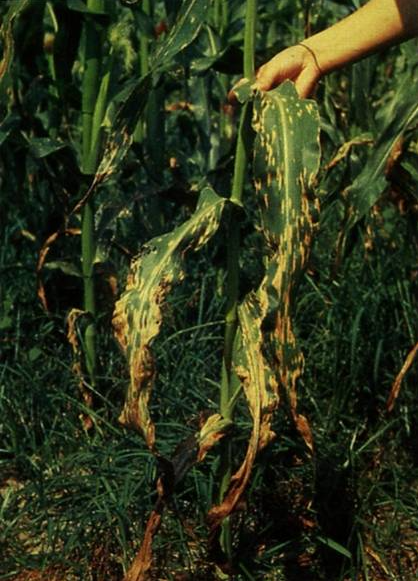
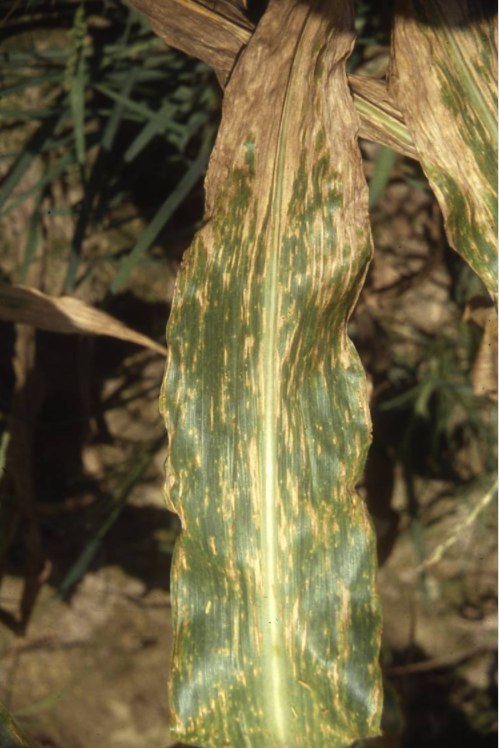
Damage to crop: Corn leaf blight can be further classified into northern corn leaf blight and southern corn leaf blight, both mainly damage the leaves, sheaths, and bracts of corn. The lesions of large leaf spot are yellowish brown or grayish brown. Lesions of northern corn leaf blight is larger in size, which can grow to 10 cm in length and 1 cm in width. Lesions of southern corn leaf blight is smaller in size, which can be 1 cm in length and 4 mm in width. Under high humidity, a layer of black mold will grow on the lesion. The lesion enlarges when the disease progress, eventually leading to the withering of leaf.
Hosts: Common hosts of corn leaf blight include members of Gramineae crops such as corn and rice.
Prevention and treatment:
- Cultivate disease resistant maize.
- Till the soil thoughtfully after harvesting the crops to accelerate the decomposition of the infected remains.
- Practice crop rotation.
- Sow the seed earlier to avoid the peak season of disease.
- Spraying effective fungicide such as Mancoze (2P127), Zineb (2P194), Carbendazim, and Anilazine.
Purple Blotch
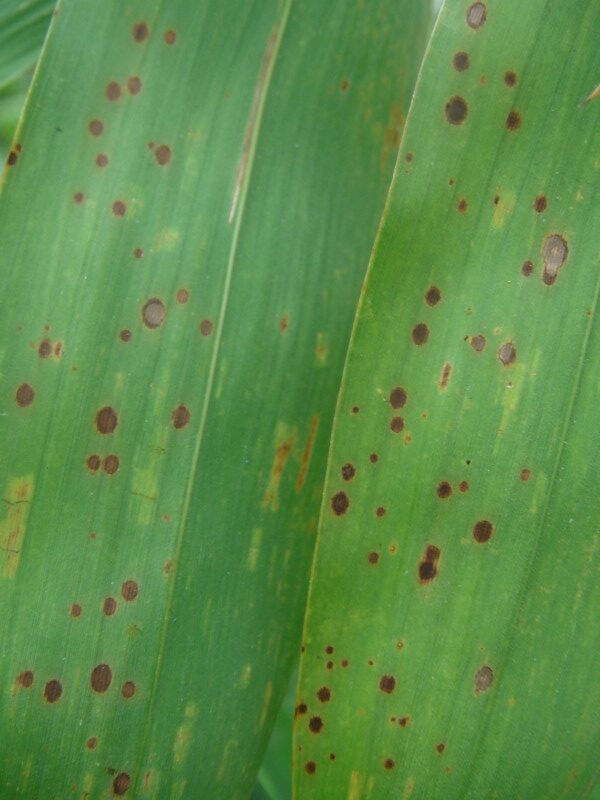
Damage to crop: Purple blotch infects the leaves, pedicels, and bulbs of onions or leeks. After harvest, the fungal spore will live in the harvested crops and continue the infection. The disease often begins as small, oval-shaped lesions in pale brown. Lesions enlarge and turn to purple or brown as the disease progresses. The infected region is often covered by dark-gray mold in rings under high humidity. After infection, leaves easily dry and wither. In severe cases, a large number of leaves will die.
Hosts: Common hosts of purple blotch include members of Liliaceae crop such as onions, garlic, leeks, garlic chives etc.
Prevention and treatment:
- Practice crop rotation.
- Use uninfected seeds or disinfected seeds
- 3. Remove stubbles and infected parts. Burn or bury them deeply to avoid contamination.
- Spraying effective fungicide such as Mancozeb (2P127), Chlorothalonil (2P47), oxadixyl-mancozeb, Difolatan, Captafol, iprodione, carbendazim or polyoxin.
*Details of sources and reference please refer to the Chinese version.
